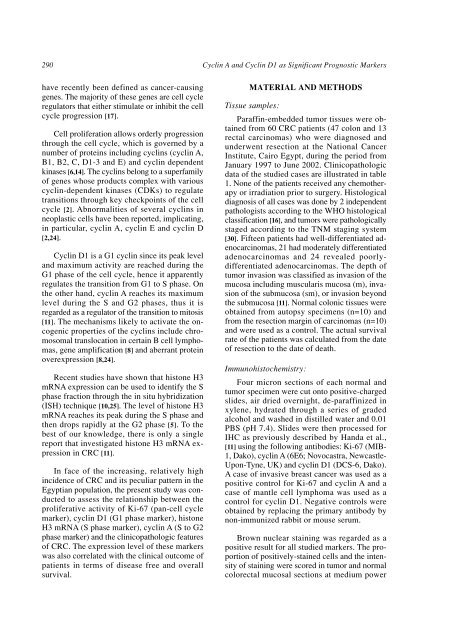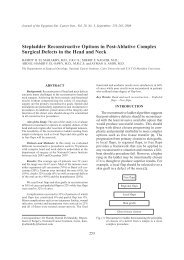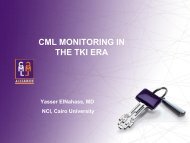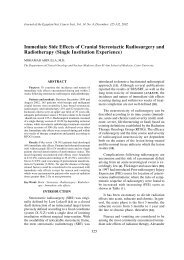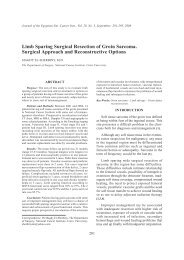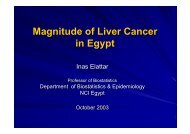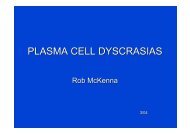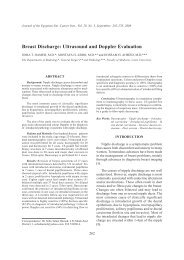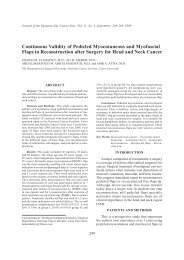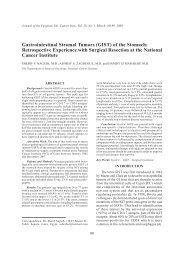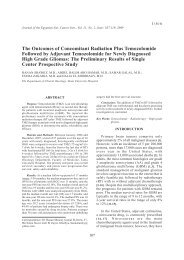Full text - PDF - The National Cancer Institute
Full text - PDF - The National Cancer Institute
Full text - PDF - The National Cancer Institute
Create successful ePaper yourself
Turn your PDF publications into a flip-book with our unique Google optimized e-Paper software.
290Cyclin A and Cyclin D1 as Significant Prognostic Markershave recently been defined as cancer-causinggenes. <strong>The</strong> majority of these genes are cell cycleregulators that either stimulate or inhibit the cellcycle progression [17].Cell proliferation allows orderly progressionthrough the cell cycle, which is governed by anumber of proteins including cyclins (cyclin A,B1, B2, C, D1-3 and E) and cyclin dependentkinases [6,14]. <strong>The</strong> cyclins belong to a superfamilyof genes whose products complex with variouscyclin-dependent kinases (CDKs) to regulatetransitions through key checkpoints of the cellcycle [2]. Abnormalities of several cyclins inneoplastic cells have been reported, implicating,in particular, cyclin A, cyclin E and cyclin D[2,24].Cyclin D1 is a G1 cyclin since its peak leveland maximum activity are reached during theG1 phase of the cell cycle, hence it apparentlyregulates the transition from G1 to S phase. Onthe other hand, cyclin A reaches its maximumlevel during the S and G2 phases, thus it isregarded as a regulator of the transition to mitosis[11]. <strong>The</strong> mechanisms likely to activate the oncogenicproperties of the cyclins include chromosomaltranslocation in certain B cell lymphomas,gene amplification [8] and aberrant proteinoverexpression [8,24].Recent studies have shown that histone H3mRNA expression can be used to identify the Sphase fraction through the in situ hybridization(ISH) technique [10,25]. <strong>The</strong> level of histone H3mRNA reaches its peak during the S phase andthen drops rapidly at the G2 phase [5]. To thebest of our knowledge, there is only a singlereport that investigated histone H3 mRNA expressionin CRC [11].In face of the increasing, relatively highincidence of CRC and its peculiar pattern in theEgyptian population, the present study was conductedto assess the relationship between theproliferative activity of Ki-67 (pan-cell cyclemarker), cyclin D1 (G1 phase marker), histoneH3 mRNA (S phase marker), cyclin A (S to G2phase marker) and the clinicopathologic featuresof CRC. <strong>The</strong> expression level of these markerswas also correlated with the clinical outcome ofpatients in terms of disease free and overallsurvival.MATERIAL AND METHODSTissue samples:Paraffin-embedded tumor tissues were obtainedfrom 60 CRC patients (47 colon and 13rectal carcinomas) who were diagnosed andunderwent resection at the <strong>National</strong> <strong>Cancer</strong><strong>Institute</strong>, Cairo Egypt, during the period fromJanuary 1997 to June 2002. Clinicopathologicdata of the studied cases are illustrated in table1. None of the patients received any chemotherapyor irradiation prior to surgery. Histologicaldiagnosis of all cases was done by 2 independentpathologists according to the WHO histologicalclassification [16], and tumors were pathologicallystaged according to the TNM staging system[30]. Fifteen patients had well-differentiated adenocarcinomas,21 had moderately differentiatedadenocarcinomas and 24 revealed poorlydifferentiatedadenocarcinomas. <strong>The</strong> depth oftumor invasion was classified as invasion of themucosa including muscularis mucosa (m), invasionof the submucosa (sm), or invasion beyondthe submucosa [11]. Normal colonic tissues wereobtained from autopsy specimens (n=10) andfrom the resection margin of carcinomas (n=10)and were used as a control. <strong>The</strong> actual survivalrate of the patients was calculated from the dateof resection to the date of death.Immunohistochemistry:Four micron sections of each normal andtumor specimen were cut onto positive-chargedslides, air dried overnight, de-paraffinized inxylene, hydrated through a series of gradedalcohol and washed in distilled water and 0.01PBS (pH 7.4). Slides were then processed forIHC as previously described by Handa et al.,[11] using the following antibodies: Ki-67 (MIB-1, Dako), cyclin A (6E6; Novocastra, Newcastle-Upon-Tyne, UK) and cyclin D1 (DCS-6, Dako).A case of invasive breast cancer was used as apositive control for Ki-67 and cyclin A and acase of mantle cell lymphoma was used as acontrol for cyclin D1. Negative controls wereobtained by replacing the primary antibody bynon-immunized rabbit or mouse serum.Brown nuclear staining was regarded as apositive result for all studied markers. <strong>The</strong> proportionof positively-stained cells and the intensityof staining were scored in tumor and normalcolorectal mucosal sections at medium power


